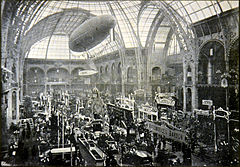Ville de Paris (airship, 1903)
The Ville de Paris ( French for City of Paris ) was a French impact airship completed in 1903 . It served as a much-noticed exhibition object, but did not prove itself in the air.

history
Between 1901 and 1903, Henry Deutsch de la Meurthe had a new kind of airship built by the Société Mallet, Mélandri et de Pitray according to plans by the designer Victor Tatin .
On a Friday afternoon in December 1903, the airship, still secured by ropes, rose for the first time in the park of Saint-Cloud . Among the invited observers in Paris were representatives of foreign automobile clubs and the designers of the rival Lebaudy airship .
With its designer Tatin, the pilot Nicolleau and the on-board mechanic Pain as crew on board, the Ville de Paris took off briefly. The engine ran but could not turn the propeller. After a few minutes the attempt to take off was canceled and the airship was brought back to its hangar . Because of the noticeable instability, a free flight of this Ville de Paris was never risked.
Henri Deutsch de la Meurthe relocated his airship activities near Sartrouville and in 1906 had a new airship called Ville de Paris built, this time based on plans by the designer Édouard Surcouf.
description
The Ville de Paris consisted of a balloon stabilized by the excess pressure of its gas filling. Two rows of ropes attached to its long sides carried an elongated gondola.
The lenticular balloon envelope filled with hydrogen under 2 millibars pressure had a length of 56.8 m and a circumference of 8.18 m and a volume of 2,100 m 3 . An air-filled ballonet with a volume of 200 m 3 and a pressure of 1.5 millibars was fixed in the envelope 20.4 m behind the bow tip. The total weight of the double-layer cover made of Japanese silk on the inside and heavier French silk on the outside was about 350 kg. A side stabilizer three meters high and four meters long was mounted under the tail tip of the balloon.
The gondola was a 200 kg heavy, 30 m long slatted frame with the seats of the crew. Inside, a ballast sled on rails could be moved twelve meters lengthways using cable pulls in order to balance the airship or to tilt it for ascent and descent.
A 370 kg heavier four-cylinder engine of the brand Mors made 60 or 63 hp at 930 min -1 and consumed using 25 kg of fuel per hour. The cooling system required 40 liters of water. The 100 kg two-bladed propeller with a diameter of 7 m was attached to the stern of the nacelle.
Exhibit
At the Salon de l'automobile, du cycle, et des sports from December 10th to 25th, 1901, an airship Ville de Paris was hung as an exhibition object under the glass roof of the Grand Palais . The balloon envelope intended for use, however, was not built until the early months of 1903.
Individual evidence
- ^ A b Present Status of Military Aeronautics "Ville de Paris" (Fig. 4). Flightglobal, February 27, 1909, p. 137 , accessed July 20, 2017 .
- ↑ a b c La "Ville de Paris". l'Aérophile, February 1903, p. 48 , accessed on July 20, 2017 (French).
- ^ A b c d e f François Peyrey: L'Aéronat "La Ville-de-Paris". La Vie au grand air: revue illustrée de tous les sports, December 24, 1903, p. 966 , accessed on July 23, 2017 (French).
- ↑ a b Ladislas d'Orcy (Ed.): D'Orcy's Airship Manual . The Century Co., New York 1917, p. 97 (English, online ).